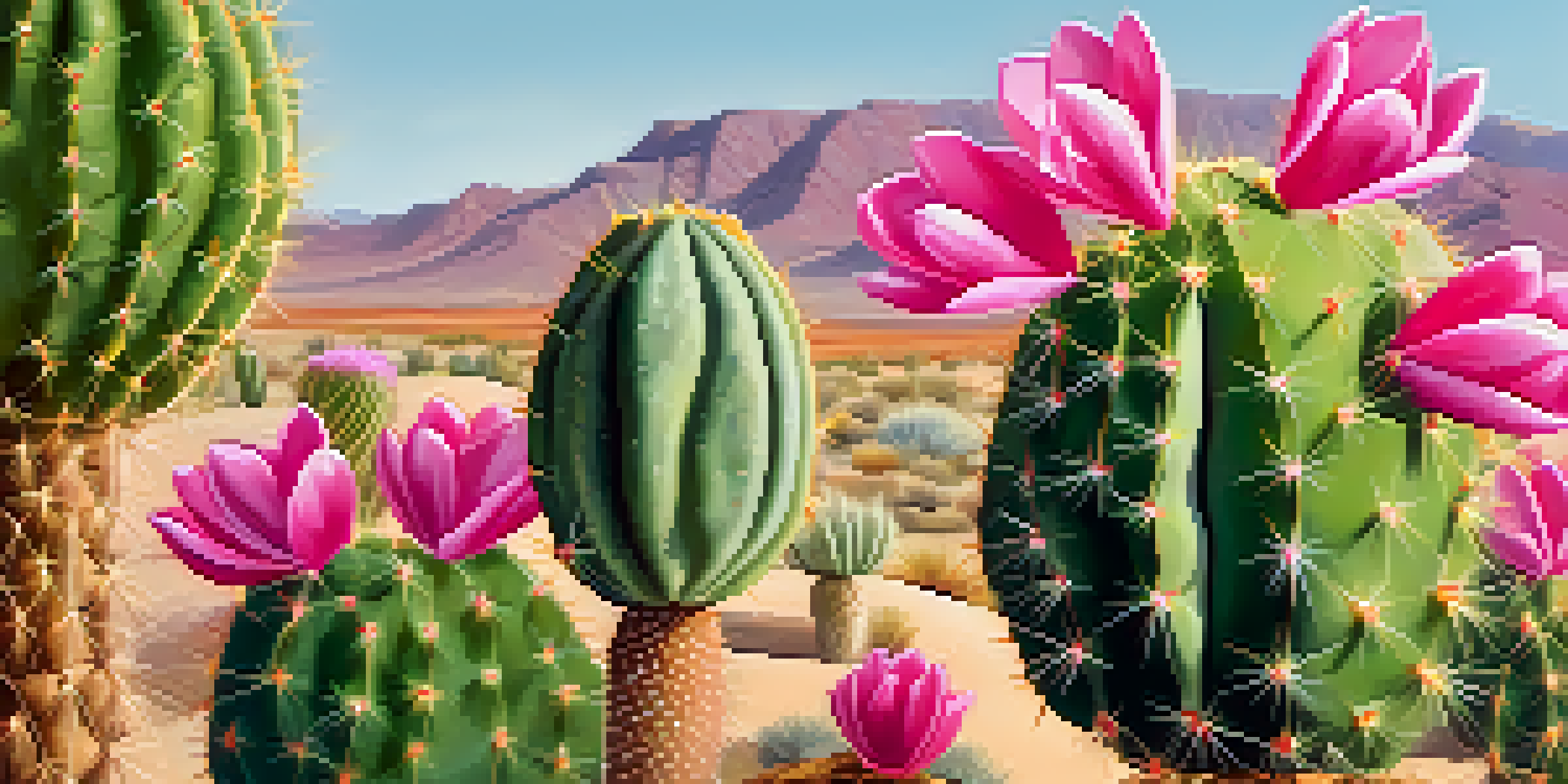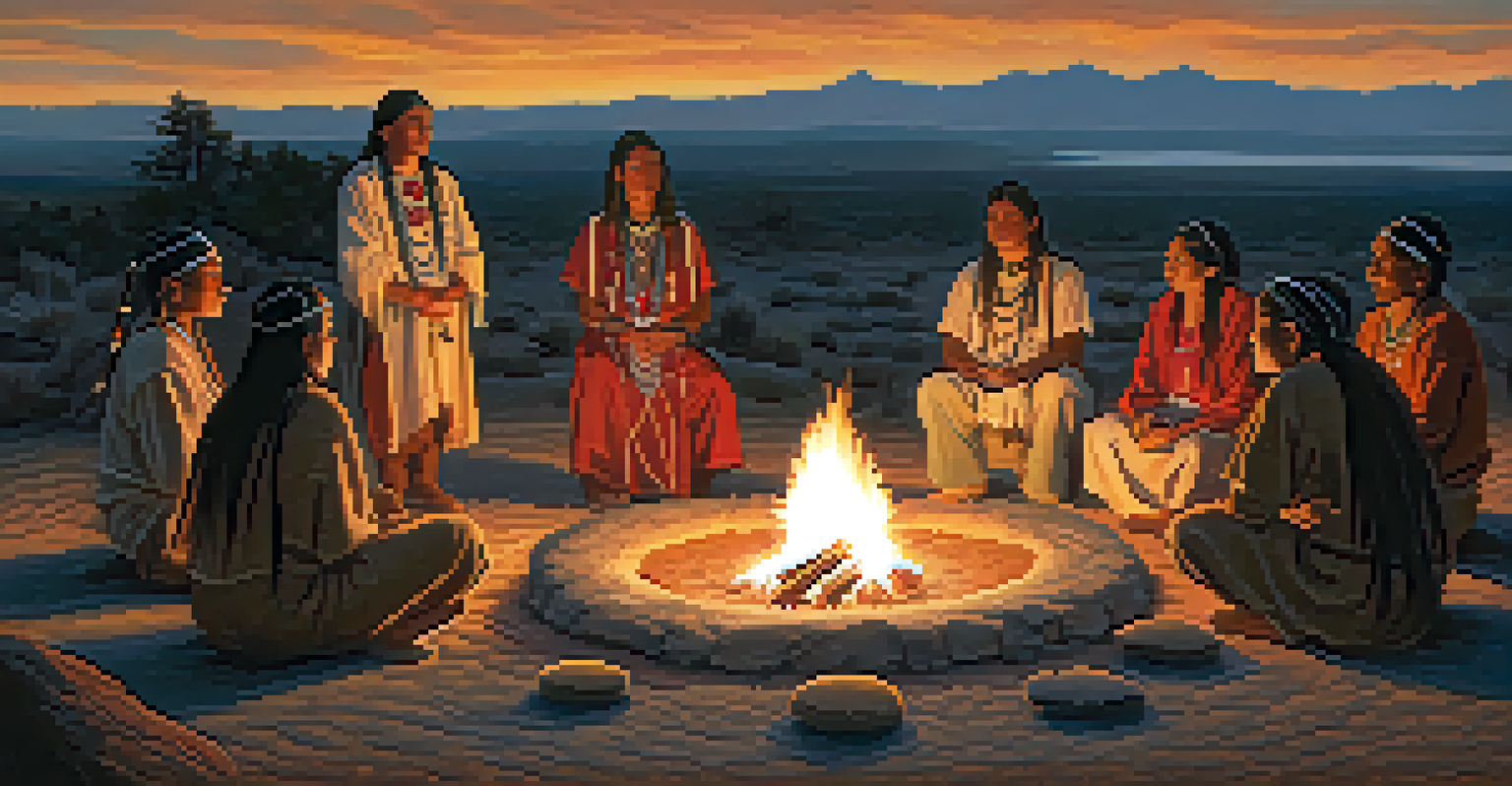Peyote's Influence on Spiritual Identity in Indigenous Cultures

Understanding Peyote: A Sacred Cactus
Peyote, scientifically known as Lophophora williamsii, is a small, spineless cactus native to the southwestern United States and Mexico. Known for its psychoactive properties, this cactus has been used for centuries by Indigenous peoples for spiritual and ceremonial purposes. Its significance extends beyond its physical attributes, as it embodies a deep connection to the spiritual realm and the natural world.
The use of peyote is a deeply spiritual practice that connects us to our ancestors and the natural world.
Traditionally, Indigenous cultures view Peyote as a gift from the Creator, integral to their spiritual practices. The psychoactive compounds, particularly mescaline, facilitate profound experiences that promote introspection and a sense of unity with the universe. For many, consuming Peyote is not just a ritual; it's a pathway to understanding one's place in the cosmos.
As Peyote continues to be a focal point in various Indigenous ceremonies, it plays a vital role in their cultural identity. The rituals surrounding its use foster community bonds and reinforce shared beliefs, making it much more than a mere plant—it's a symbol of heritage and resilience.
Peyote in Native American Church Practices
The Native American Church (NAC) is one of the most prominent organizations that incorporates Peyote into its spiritual practices. Founded in the late 19th century, the NAC blends elements of traditional Indigenous spirituality with Christianity, creating a unique religious framework. Peyote ceremonies in this context aim to promote healing, personal growth, and connection to a higher power.

During these ceremonies, participants often consume Peyote in a structured setting, guided by a leader or spiritual elder. The experience is characterized by singing, drumming, and prayer, creating an atmosphere of collective spirituality. This communal aspect of Peyote use reinforces a shared identity among participants, fostering a sense of belonging and support.
Peyote's Role in Spiritual Practices
Peyote serves as a vital element in Indigenous spiritual practices, facilitating profound experiences that promote introspection and community bonding.
Moreover, the NAC advocates for the legal protection of Peyote use, emphasizing its importance to spiritual identity and cultural survival. This ongoing struggle highlights the resilience of Indigenous communities in preserving their traditions despite external pressures and challenges.
Cultural Significance of Peyote in Indigenous Traditions
Peyote's influence in Indigenous cultures goes far beyond its ceremonial use; it's deeply woven into their myths, stories, and worldviews. Many Indigenous tribes regard Peyote as a teacher, offering insights and guidance that shape their understanding of life and death. These teachings are often shared through oral traditions, connecting generations and reinforcing communal values.
Peyote is more than a plant; it is a pathway to understanding oneself and the universe.
For instance, some tribes believe that Peyote allows individuals to communicate with ancestors, bridging the past and present. This spiritual connection fosters a strong sense of identity and belonging, as individuals feel part of a larger narrative that transcends time. Such beliefs instill pride in cultural heritage, encouraging younger generations to embrace their roots.
Additionally, the symbolism of Peyote extends to concepts of growth and renewal. Just as the cactus survives in harsh environments, it represents resilience and adaptability, qualities that many Indigenous cultures value. Through these narratives, Peyote serves as a powerful reminder of the strength found in cultural identity.
The Role of Peyote in Healing Practices
Healing is a fundamental aspect of many Indigenous cultures, and Peyote plays a crucial role in these practices. Traditionally, Peyote is used to treat not just physical ailments, but also emotional and spiritual distress. The ceremonies surrounding its consumption often involve prayers and rituals aimed at restoring balance and harmony within the individual and the community.
Participants frequently report transformative experiences during Peyote ceremonies, describing feelings of catharsis and clarity. These healing journeys can help individuals confront personal traumas and gain insights into their lives, fostering a sense of empowerment. Such experiences not only aid individual healing but also promote collective wellness within the community.
Cultural Significance and Resilience
Peyote symbolizes resilience and cultural identity for Indigenous peoples, reinforcing their connection to ancestral traditions and heritage.
Moreover, the integration of Peyote in healing practices reflects a holistic approach to health, emphasizing the interconnectedness of mind, body, and spirit. This perspective is pivotal in Indigenous cultures, where well-being is viewed as a balance of all aspects of life, showcasing the profound impact of Peyote on spiritual identity.
Modern Challenges and the Future of Peyote Use
Despite its deep-rooted significance, Peyote faces numerous challenges in the modern world. Overharvesting, habitat loss, and increased demand for the cactus threaten its availability for Indigenous peoples who rely on it for spiritual practices. As a result, there are growing concerns about the sustainability of Peyote and the implications for cultural identity.
Additionally, the encroachment of Western perspectives on spirituality can dilute the traditional practices surrounding Peyote. As more individuals outside Indigenous communities seek out Peyote experiences, there’s a risk of commodification, which can undermine its sacred nature. This highlights the importance of respecting Indigenous wisdom and practices in discussions about Peyote.
Looking ahead, it’s crucial for Indigenous communities to advocate for the protection of Peyote and its cultural significance. By fostering awareness and understanding, they can help ensure that future generations can continue to engage with this sacred plant in meaningful ways, preserving their spiritual identity amidst a rapidly changing world.
Peyote as a Symbol of Resilience and Identity
Peyote stands as a powerful symbol of resilience for many Indigenous cultures. Its enduring presence in spiritual practices reflects a commitment to cultural preservation and a resistance to assimilation. Through the continued use of Peyote, Indigenous peoples assert their identity and reaffirm their connection to ancestral traditions, even in the face of adversity.
This resilience is not just about survival; it's about thriving and maintaining a sense of self in a complex world. Peyote ceremonies create spaces for individuals to explore their spirituality, fostering personal growth and community solidarity. Such experiences are vital in reinforcing cultural identity and ensuring the transmission of traditions to future generations.
Environmental Interconnectedness
The use of Peyote highlights the deep connection between nature and spirituality, emphasizing the importance of sustainable practices and environmental stewardship.
Ultimately, Peyote embodies the strength of Indigenous peoples' connection to their heritage. It serves as a reminder of their enduring spirit and the importance of honoring their cultural practices, allowing them to navigate contemporary challenges while staying true to their roots.
The Interconnectedness of Nature and Spirituality
One of the most profound aspects of Peyote use in Indigenous cultures is its embodiment of the interconnectedness between nature and spirituality. Peyote is not viewed as a separate entity; rather, it is part of a larger ecosystem that includes humans, animals, and the land. This perspective fosters a deep respect for the environment and highlights the importance of sustainable practices.
By integrating Peyote into their spiritual practices, Indigenous peoples acknowledge their reliance on nature for guidance and wisdom. This connection encourages a holistic worldview where every element of the natural world has significance and purpose. Such beliefs inspire stewardship of the land and a commitment to preserving the environment for future generations.

As society increasingly confronts environmental challenges, the lessons learned from Indigenous perspectives on nature and spirituality can offer valuable insights. Recognizing the sacredness of the natural world, as exemplified by Peyote, can inspire a more harmonious relationship between humans and the environment, fostering a sense of responsibility and care.